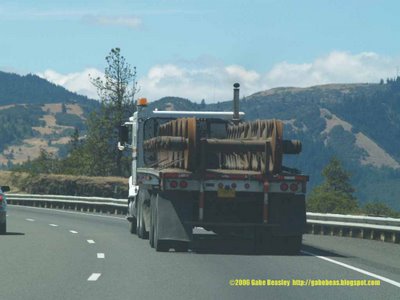
Mom and I were driving to Hood River--speaking of trains--Jese! I hope this guy does not crash. Each one of those must be as heavy as the truck that is carrying it.
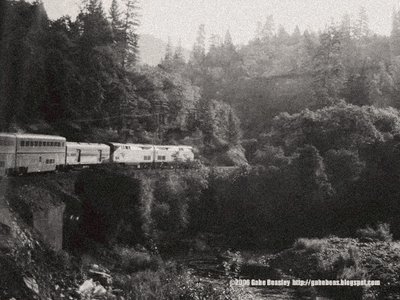
A BIT OF GLARE AND DEFUSED LIGHT CONTROL Ver.1.0
This was my best shot yet of the crew car and our locomotives. But it had problems. I spent an hour or two in Photoshop having some fun and this is what I got. I cut levels off sharply to emulate old fashioned films and I was able to completely remove the serious glare and clear the ghostly projection of an elderly man who is sitting right in the center of the picture (below)! Glare and reflections is a big problem on trains. If you are only shooting 35mm you better take allot of shots! When I shoot 35mm sometimes I take my compact digital out and "plot" a good angle and settings to take a 35mm or 120 shot at. If you have time to do this--a test of lighting and ISO emulation can make for the ultimate light meter.
Then shoot your picture with your film camera. No matter what, in time you learn how to get around the worst of it on the train or in your "digital darkroom" or when you get your prints. I may yet be able bring up the slight colors in the RAW image and do a color version of this. On a train it is best to try to get a clean window seat--and you usually can if your smart and fast. The observation car has the worst glare and ironically it's often the worst place to take pictures. Try it from your seat and try to get a window as clean as possible. Using a longer lens zoom is the best idea to minimize problems caused by dried water droplets and other nasty effects. Your flash is useless--it won't penetrate the glass. It took me a large flashgun to finally do that--so bright it startled people. You can't take pictures outside the train by flash. Making friends with the right crew member might allow you to open a window--but DONT TRY THIS without asking--they usually think you were smoking and can throw you off the train!
Time of day has a great deal to do with window pictures due to glare inside the laminated glass. Be sure to keep that in mind and not give up right away. I've shot pictures that are in this website so good from the train that it's as good as if I was riding outside. It all depends on the situation. This is what it looked like before--notice the projected man in the bottom half of the image. Click for larger view.
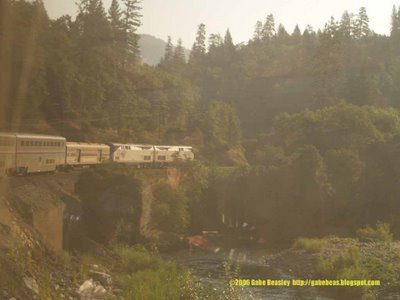
(BEFORE)
I was not going to show this but here is the picture BEFORE I touched it with Photoshop editing.
Notice the ghost like images and glare. An elderly man can be seen right in the center of this image (click larger view). I suppose I could have said "I swear, this image was taken from my seat and I have no idea how this happened--the train was dark--it's a ghost, these trains are haunted!" I will pass- I've seen the sometimes pathetic hoaxes and as only an amateur photographer I notice how most of them are done and wonder how dishonest someone will be just to get on TV. I've been on TV a few times, it is no big deal. I am very amazed what some people will do to get on TV these days. The worst of our psychological septic system is revealed in those daytime TV talk shows and small claims court programs.
The old guy might be a bit hard to see, like one of those puzzle pictures. His hand on an invisible table but his fingers and ring are very clear. And his head is right on and then below the first locomotive. This guy was behind me when I shot this picture. A big problem with train shots are reflections like this. In the bottom center of this image very clear reflected object can be seen above the creek. If you can't make out that man, I'm sure you can see the rest of the glare and how I removed it. All the haze is a product of the tinted thick bullet-resistant train windows and the glare in them. Years of use has also made the lamination not as good as it once was.
 You sure do get allot of opportunities for nice shots on the train you never would get on the road or find in back roads. Using a GPS it is possible to mark your train spots and try to get back to them in a car someday for better pictures.
You sure do get allot of opportunities for nice shots on the train you never would get on the road or find in back roads. Using a GPS it is possible to mark your train spots and try to get back to them in a car someday for better pictures. I was under the station, carrying all this gear--and somebody told me to go the wrong way. I had to howl all my stuff back up but before I went I shot a quick picture of this underground walkway. Lights at night can do all kinds of cool things if you have a good enough camera. If you get a digital SLR make sure it at least goes above 1000iso. I think they all go higher then that but you will want those speeds. Pro-films emulated, they let you take pictures anywhere without a flash if you are good at it. 1600 is enough for most stuff.
I was under the station, carrying all this gear--and somebody told me to go the wrong way. I had to howl all my stuff back up but before I went I shot a quick picture of this underground walkway. Lights at night can do all kinds of cool things if you have a good enough camera. If you get a digital SLR make sure it at least goes above 1000iso. I think they all go higher then that but you will want those speeds. Pro-films emulated, they let you take pictures anywhere without a flash if you are good at it. 1600 is enough for most stuff.


 Another picture I have not played with in Photoshop yet. It could use some work. I wished I could go outside and clean the windows. That is not going to happen!
Another picture I have not played with in Photoshop yet. It could use some work. I wished I could go outside and clean the windows. That is not going to happen!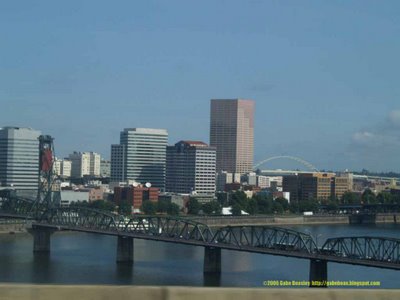
Portland Oregon, the nearest major city to The Dalles. I have lived here off and on or near for most of my life. You should practice to get shots like this, on a train or in a car. But I must admit luck is a serious factor. Often a photographer's worst nightmare is to have someone tell you that we are in a hurry and we got to go now! A sure way to drive any photographer crazy! It's literally painful!
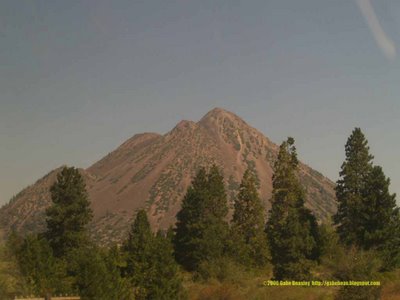 I am not sure where this is except that it is probably southern Oregon. I have a GPS that by map would tell me, but I only keep track of points I want to re-photograph and forgot to take it out to ID many of these mountains and hills. If you are a serious photographer, Amateur or Pro-- you will want to get a GPS. A good new simple handheld GPS with a built-in US, area, or World map can tell you when you are traveling where things are quickly as you "fly" through the virtual landscape. It will track all your travels down to less then 100ft or so. You can mark an area you want to photograph with notes on a good GPS for later. You don't have to write down navigation coordinates--I can mark the map with a place and save that place with a note--all done with a somewhat like a PDA. I never even look at my exact position and those numbers. Modern GPS units take care of all that for you. I use this on the train to find points that I will need to be ready for when we go by them on the train the next time. Units now days don't just give you your latitude and longitude--they tell you everything from elevation to the next McDonalds to park or historical landmark. They usually don't work in metal vehicles, incredibly-Mine works fine when placed near or on the window of the train EVERY TIME. Really useful to know where you are even when the crew is not sure!
I am not sure where this is except that it is probably southern Oregon. I have a GPS that by map would tell me, but I only keep track of points I want to re-photograph and forgot to take it out to ID many of these mountains and hills. If you are a serious photographer, Amateur or Pro-- you will want to get a GPS. A good new simple handheld GPS with a built-in US, area, or World map can tell you when you are traveling where things are quickly as you "fly" through the virtual landscape. It will track all your travels down to less then 100ft or so. You can mark an area you want to photograph with notes on a good GPS for later. You don't have to write down navigation coordinates--I can mark the map with a place and save that place with a note--all done with a somewhat like a PDA. I never even look at my exact position and those numbers. Modern GPS units take care of all that for you. I use this on the train to find points that I will need to be ready for when we go by them on the train the next time. Units now days don't just give you your latitude and longitude--they tell you everything from elevation to the next McDonalds to park or historical landmark. They usually don't work in metal vehicles, incredibly-Mine works fine when placed near or on the window of the train EVERY TIME. Really useful to know where you are even when the crew is not sure!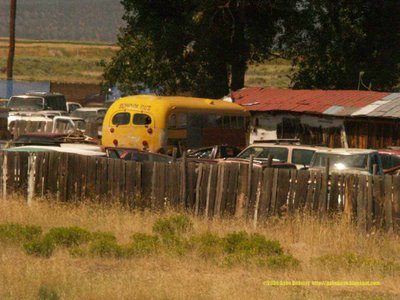 This bus is one of countless buses and other vehicles are all over out in the desert. Like in the movies, there is no shortage of them and they can really take you back. I look at some and go "..oh yah, that's mom's old car!"
This bus is one of countless buses and other vehicles are all over out in the desert. Like in the movies, there is no shortage of them and they can really take you back. I look at some and go "..oh yah, that's mom's old car!"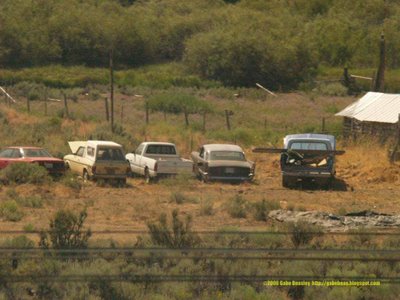 More dead or dieing autos. The graveyard goes on for miles.
More dead or dieing autos. The graveyard goes on for miles. Dump trucks, motor homes--being into junk and experimenting with it--I'd have allot of fun out here.
Dump trucks, motor homes--being into junk and experimenting with it--I'd have allot of fun out here. I think this is Mount Shasta. But I am not sure. I shot this from the train with a long-lens. The train actually pretty stable but I also use a trick on my camera. I have an L bracket and a tripod top which seriously stabilizes the camera by putting force stability in the right places. Between my eye through the eyecup, the handles and my chin through a part of a tripod mount. I wonder if anyone markets this kind of device? I invented the idea of using the top end of a tripod for this and it works very well. I doubt a patent is worth it since image stabilization is being added to the new generations of digital SLRs
I think this is Mount Shasta. But I am not sure. I shot this from the train with a long-lens. The train actually pretty stable but I also use a trick on my camera. I have an L bracket and a tripod top which seriously stabilizes the camera by putting force stability in the right places. Between my eye through the eyecup, the handles and my chin through a part of a tripod mount. I wonder if anyone markets this kind of device? I invented the idea of using the top end of a tripod for this and it works very well. I doubt a patent is worth it since image stabilization is being added to the new generations of digital SLRs An old shack, probably from the old west era. Ranchers often had to spend time out during winter or at other times to check fences. A long and complex ride on a horse. It's hard to imagine how much work they used to have to do. Only to come home to this kind of shack not much larger then an outhouse. I got the shot--what's really interesting is to get into one of these places. My dad and I have found several in the middle of nowhere somewhat un-disturbed with all kinds of interesting old stuff in them.
An old shack, probably from the old west era. Ranchers often had to spend time out during winter or at other times to check fences. A long and complex ride on a horse. It's hard to imagine how much work they used to have to do. Only to come home to this kind of shack not much larger then an outhouse. I got the shot--what's really interesting is to get into one of these places. My dad and I have found several in the middle of nowhere somewhat un-disturbed with all kinds of interesting old stuff in them.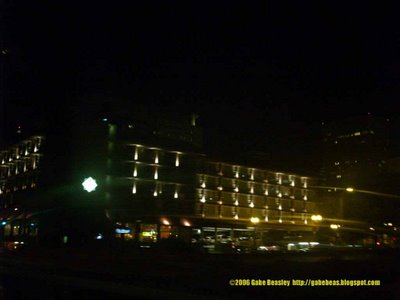 Lights at night can make really cool shots.
Lights at night can make really cool shots. Now this has got to be Mt. Shasta? Sorry but I can't tell by looks. There are quite a few mountains in Oregon.
Now this has got to be Mt. Shasta? Sorry but I can't tell by looks. There are quite a few mountains in Oregon. There is allot of chances on the train to get good shots. And better windows then this one. It takes allot of sometimes difficult and even rude actions to get pictures on the train! I may clean up more of these pictures with Photoshop--so far it's not been touched.
There is allot of chances on the train to get good shots. And better windows then this one. It takes allot of sometimes difficult and even rude actions to get pictures on the train! I may clean up more of these pictures with Photoshop--so far it's not been touched.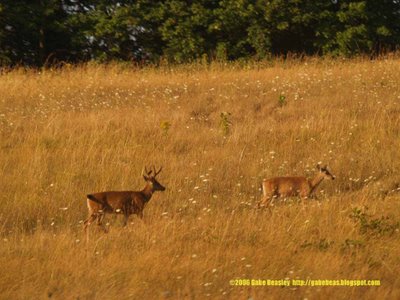 I just managed to fire a burst and got several good shots of this buck and doe. If your fast and camera is ready--you might get lucky. This was a very lucky shot as we were moving fast and I had my settings for a scene like this. High enough shutter to stop blurring, and ready to fire a burst to catch as fast as I can. Admittedly this was allot more luck then skill, somebody yelled "deer!" and I just aimed my camera.
I just managed to fire a burst and got several good shots of this buck and doe. If your fast and camera is ready--you might get lucky. This was a very lucky shot as we were moving fast and I had my settings for a scene like this. High enough shutter to stop blurring, and ready to fire a burst to catch as fast as I can. Admittedly this was allot more luck then skill, somebody yelled "deer!" and I just aimed my camera. Clearly this buck really likes her!
Clearly this buck really likes her!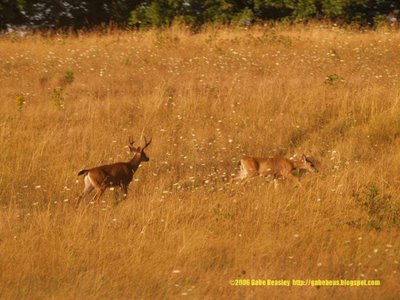 He's going for it now! I shot these pictures one at a time as we were not going very fast. My GPS can tell down to 0.5 miles an hour how fast we are moving because it does not need as much data to tell that more precisely. You can tell exactly how fast you are walking if you are just walking! It is right on with a pedometer and accurate as any car speedometer I have ever seen--everybody thinks this is cool. The GPS I got was about $400. Now days however they are much cheaper and might even have more features then mine. I have the Magellan SporTrak Pro. The SporTrak Map is less expensive last I checked. I think they have a new one for under $100. Most people still don't know GPS no longer costs what it did just a few years ago.
He's going for it now! I shot these pictures one at a time as we were not going very fast. My GPS can tell down to 0.5 miles an hour how fast we are moving because it does not need as much data to tell that more precisely. You can tell exactly how fast you are walking if you are just walking! It is right on with a pedometer and accurate as any car speedometer I have ever seen--everybody thinks this is cool. The GPS I got was about $400. Now days however they are much cheaper and might even have more features then mine. I have the Magellan SporTrak Pro. The SporTrak Map is less expensive last I checked. I think they have a new one for under $100. Most people still don't know GPS no longer costs what it did just a few years ago.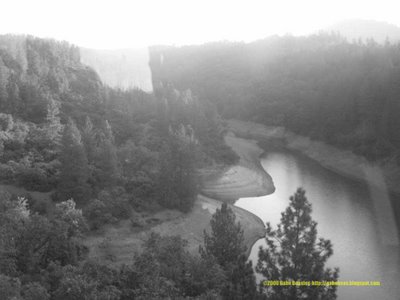 Sometimes B&W shots can cut through color problems caused by the limited bullet-resistant glass in trains and some busses. Filters try--but they can only do so much. B&W came in handy for this shot. Shooting RAW you can re-process it into color if you chose.
Sometimes B&W shots can cut through color problems caused by the limited bullet-resistant glass in trains and some busses. Filters try--but they can only do so much. B&W came in handy for this shot. Shooting RAW you can re-process it into color if you chose.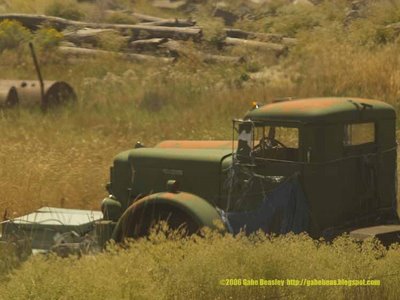 Much of the trip is in the desert. Along with seeing the hind-end of low-class America, junk yards and other abandoned things can get interesting. Getting used to shooting while moving takes time--but if you have a digital SLR you have a real advantage! But don't feel discouraged if you don't--I could have shot all this stuff with my compact with some practice and did shoot similar before I got my first digital SLR. My very first train trips and many of the pictures on this website I shot with a Kodak DX-7630. A nice camera which I still use. I modified it to use special home-built macro and wide angle lenses.
Much of the trip is in the desert. Along with seeing the hind-end of low-class America, junk yards and other abandoned things can get interesting. Getting used to shooting while moving takes time--but if you have a digital SLR you have a real advantage! But don't feel discouraged if you don't--I could have shot all this stuff with my compact with some practice and did shoot similar before I got my first digital SLR. My very first train trips and many of the pictures on this website I shot with a Kodak DX-7630. A nice camera which I still use. I modified it to use special home-built macro and wide angle lenses. I might come back and do some work on this shot as well--but I could not wait to show it. If I recall, this is the only covered bridge in Oregon or no, maybe he said the longest. I forget. If I get allot of time I will change my white balance on this shot and do a few other things that would make this picture look far better. It's shot in RAW so I can do more with it then when I used to shoot in JPEG.
I might come back and do some work on this shot as well--but I could not wait to show it. If I recall, this is the only covered bridge in Oregon or no, maybe he said the longest. I forget. If I get allot of time I will change my white balance on this shot and do a few other things that would make this picture look far better. It's shot in RAW so I can do more with it then when I used to shoot in JPEG. The sun rizes and goes down on every trip.
The sun rizes and goes down on every trip.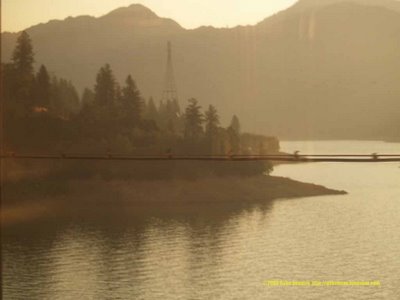 Sometimes circumstances come together in just the right way. I'm not sure where this was, but keeping glare out of some of these shots I found out was possible by putting my hands around my lens-hood. I was ready for this shot, if you want to get shots on the train--you must have your camera ready to go at any moment. Do not be afraid of people--the more you tell them about your interest and show them you are not taking their pictures the better!
Sometimes circumstances come together in just the right way. I'm not sure where this was, but keeping glare out of some of these shots I found out was possible by putting my hands around my lens-hood. I was ready for this shot, if you want to get shots on the train--you must have your camera ready to go at any moment. Do not be afraid of people--the more you tell them about your interest and show them you are not taking their pictures the better! Once again I am not sure where this is. A fast boat comes towards us. I'd love to be able to step outside to take shots. The best I could do from inside the train. Laminated nearly half-inch bullet resistant tinted glass demands changing your settings and being alert for that very quick fleeting shot. The train stops sometimes, but you normally can never get off unless your at a station.
Once again I am not sure where this is. A fast boat comes towards us. I'd love to be able to step outside to take shots. The best I could do from inside the train. Laminated nearly half-inch bullet resistant tinted glass demands changing your settings and being alert for that very quick fleeting shot. The train stops sometimes, but you normally can never get off unless your at a station.
No comments:
Post a Comment